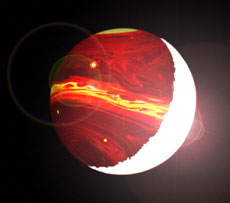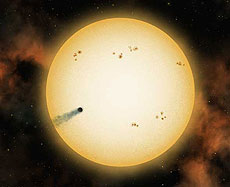July 11, 2005
Discovery of planet with a massive core lends support to a planet formation theory
By Tim Stephens and Denize Springer
Astronomers have discovered an extrasolar planet with the largest core of any known planet. The discovery is especially exciting to planet formation theorists, because it provides extremely strong observational evidence in support of the "core accretion" theory, one of two main theories for how giant planets form.

Artist's concept of the newly discovered planet as it would appear in a crescent phase. Light emitted from the "dark side" is due to the heat of the planet and reveals flow patterns in the planet's turbulent atmosphere.
Image: Gregory Laughlin and James Cho |

Artist's concept of the newly discovered planet as it passes in front of the host star
Image: Lynette Cook |
The findings were made by a consortium of American, Japanese, and Chilean astronomers led by Debra Fischer of San Francisco State University and Gregory Laughlin of UCSC.
A paper about the discovery has been accepted for publication in the Astrophysical Journal.
"We started this project with the hope of finding an object like this," said Laughlin, a professor of astronomy and astrophysics. "There is a raging debate over the mechanism that formed Jupiter and the giant planets found around other stars. This planet could only have formed through some variation on the core accretion process, so it is extraordinary evidence in favor of that theory."
The astronomers initially detected the planet by measuring the tiny wobble that its gravitational tug induces in the host star. They were then able to make valuable observations of the planet as it passed in front of the star.
"This planet passes in front of its star and dims the starlight," said Debra Fischer, a professor of astronomy at SFSU and team leader for the consortium. "When that happens, we are able to calculate the physical size of the planet, whether it has a solid core, and even what the planet atmosphere is like."
The planet, orbiting the Sun-like star HD 149026, takes just 2.87 days to circle around its star. It is roughly equal in mass to Saturn, but it is significantly smaller in diameter.
"We all expected a much larger planet, similar to Jupiter," said Bun'ei Sato, a postdoctoral fellow at Okayama Astrophysical Observatory and first author of the paper. "None of our models predicted that nature could make a planet like this."
Modeling of the planet's structure by Peter Bodenheimer, a professor of astronomy and astrophysics at UCSC, showed that the planet has a solid core that is about 70 times the mass of Earth.
"Its total mass is close to Saturn's, but it has a much larger core," Bodenheimer said.
"For theorists, the discovery of a planet with such a large core is as important as the discovery of the first extrasolar planet around the star 51 Pegasi in 1995," said Shigeru Ida, a theorist from the Tokyo Institute of Technology.
Scientists have two competing but viable theories for how planets arise from the "protoplanetary disk" of gas and dust around a star. In the first theory, planets form when a dense cloud of gas collapses due to gravitational instability in the disk. In the second, planets start as small cores of rock and ice that grow as they gravitationally acquire additional mass; when the core attains a certain critical mass, it begins to collect a gas envelope around it.
According to Laughlin, the massive core of the newly discovered planet could not have formed from a collapsing cloud of gas. The planet must have grown a core first, and then acquired gas.
"With a core of 70 Earth masses, there is really no way this planet could form through gravitational instability," Laughlin said.
Bodenheimer noted that the core of this planet is so unexpectedly massive it even poses challenges for the core accretion model. Nevertheless, he said, the evidence now strongly favors that theory over gravitational instability.
"The fact that the core is so massive may have to do with the heavy-element composition of the star, which is twice that of the Sun. So its disk probably had more solid material in it, allowing the planet to build up a bigger core," Bodenheimer said.
The researchers involved in this study are part of an international consortium established to survey "the next 2000" closest and brightest stars with "high metallicity" (meaning a composition rich in heavy elements). Called the N2K survey, it is focusing on these metal-rich stars because they are more likely than metal-poor stars to have rocky planets around them, Laughlin said.
Three of Laughlin's graduate students and an undergraduate researcher at UCSC made significant contributions to the project and are coauthors on the paper. Graduate student Mark Ammons developed statistical tools he used to mine astronomical databases and come up with a catalog of candidate stars for the survey. Two other graduate students, Sarah Robinson and Jay Strader, are performing preliminary observations of the candidate stars identified by Ammons, using the Nickel Telescope at Lick Observatory on Mt. Hamilton.
"Because observing time on the large telescopes is so valuable, you need an intermediate step to evaluate the candidate stars and determine if they are suitable for study. So they developed techniques to squeeze valuable information out of the spectra they can obtain quickly at Mt. Hamilton," Laughlin said.
Aaron Wolf, an undergraduate physics major at UCSC, developed
a software program that helps the researchers interpret the
data obtained from observations of the stars.
The consortium detected the "wobble" of the star from radial velocity measurements obtained at the Subaru Telescope and the W. M. Keck Observatory, both located on Mauna Kea in Hawaii. Follow-up observations of the dimming of the star by the planet were obtained by Gregory Henry at the Fairborn Observatory in Arizona.
Support for this research came from the National Aeronautics and Space Administration (NASA), the National Astronomical Observatory of Japan, the National Science Foundation (NSF), and Research Corporation.
 Email this story
Email this story
 Printer-friendly version
Printer-friendly version
 Return to Front Page
Return to Front Page